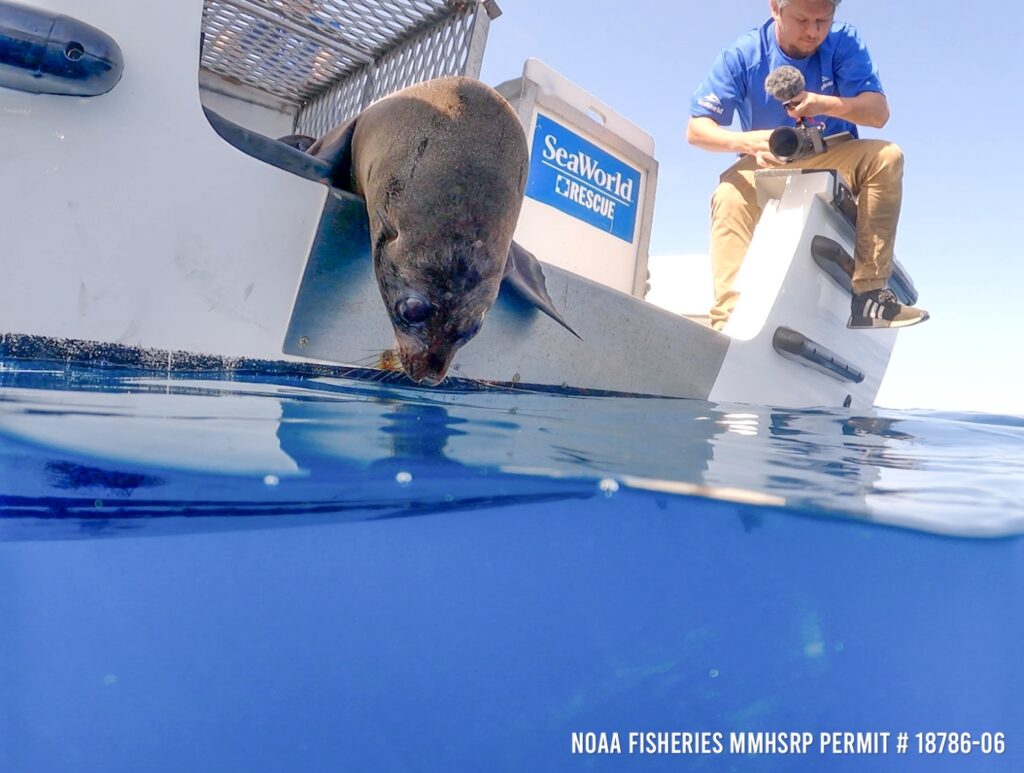
Three endangered Guadalupe fur seals rescued from near death on beaches in Orange and Los Angeles counties were returned to the ocean off La Jolla on Friday, Aug. 19, by a rescue team from San Diego SeaWorld.
The seals were at least double the weight of when they were found. Guadalupe fur seals are listed as threatened on the Endangered Species list.
The pinnipeds known as pelagic hunters, meaning they hunt in deep waters mostly eating squid, mackerel and sardines, were taken seven miles out to sea before they were released.
After hesitating just a bit, the first seal to slip into the deep blue water was Puffin, named and rescued by the Pacific Marine Mammal Center in Laguna Beach.
At only 13 pounds, she was found wedged between rocks in a Laguna Beach tidepool on Jan. 27. Volunteers fed her throughout the night. A day later, she was stable enough to travel to SeaWorld for further care. At release, she weighed 40 pounds.
“We think these overnight feedings are crucial to stabilizing them when they first arrive at the hospital,” Dr. Alissa Deming, PMMC’s veterinarian said, crediting the SeaWorld folks for their success in the long-term rehabilitation and release.
Another of the seals was rescued by the Marine Mammal Care Center Los Angeles, based in San Pedro, after being found on a beach in Santa Monica on April 5, and the third by the California Wildlife Center in Calabasas after being found at Zuma Beach in Malibu on April 16. Respectively, the two female seals weighed 15 pounds and 11 pounds. They were released at 42 pounds and 41 pounds.
“It took them a little, and then they jumped out,” Jeni Smith, a supervisor with the SeaWorld rescue team, said of Friday’s release. “They went under our boat and then headed south, and they all stayed together.”
Fur seals come from the Guadalupe Islands in Mexico and it’s thought they’ll likely head back there. It is rare to see them in waters so far north. The seals leave their mothers at between 6 and 9 months old and learn to feed and forage for themselves.
SeaWorld is the only place authorized by the National Oceanic and Atmospheric Administration that can care for the seals found in Southern California.
Critical though are the first hours when they are found. Unlike sea lions and other seals, the fur seals are more fragile because they often only come in when they are at their weakest. They also have to swim a much longer distance, diving farther to hunt for food, because they typically live in a much deeper ocean.
“Often these animals are malnourished, hypothermic and hypoglycemic,” said Dr. Lauren Palmer, veterinarian at the Marine Mammal Care Center Los Angeles. “They may be unconscious or having seizures and are literally minutes from passing away. Without intervention, they would not make it. Saving each one is critical because their population numbers are so low.”
Fishing lines, net entanglements and oil spills are some of the biggest threats, experts said. Once hunted to near extinction, their population is now estimated at 31,000, mainly due to Mexican and American government protections and ongoing rescue, rehabilitation and return efforts.
SeaWorld has rehabilitated 36 seals in the last five years.
Related Articles
New federal funds will help Southern California weather megadrought
U.S. farmers are killing their own crops and selling cows because of extreme drought
Ontario teen wins support, accolades for making sustainable period products
Four things to know about Colorado River water in California
Project to replenish sand along 12 miles of OC beaches could start in 2024, officials say
